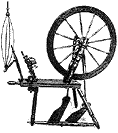
|
Welcome to the website of |
|
|
 |
|
|
|
Update October 2003 OUTING
TO
KILLERTON We set off in our coach at 10 and after a stop-over at Bickleigh Mill, arrived Killerton at 12noon. Once again we were lucky, it was still summer! The display of all things – spun, woven, dyed, knitted, crocheted and needle worked, as well as some examples of lace - was excellent. Altogether it was so stimulating to see examples of inkle looms and tablet weaving for braids, large tapestry pictures, a Navajo blanket, a very fine woven lampshade with birds flying, amongst the more day to day examples of fine spun and knitted jumpers, woven scarves, braided belts, gloves and hats, as well as skeins of space-dyed wool. Every item had some notes, and if you wanted more information a Guild member was on hand to tell you more. There were some very unusual Japanese looms on show, a round one called ‘Marudia’ for round weaving and a small stool like one called ‘Takadai’ also used for braids which looked as though you were platting with many strands and no weft, very intriguing. Altogether a very rewarding exhibition, which will stimulate new ideas for us to try, perhaps even learn a new craft. After a light lunch, some of our members walked in the park, others to look at the wedding dress collection and other things in the house, or even have another look at the Guild’s display. We set off for home around 4, after a very enjoyable day , some clutching boxes of plants from the garden shop. Yvonne Drinkwater |
|
Update May 2003 In March of this year we went on our long postponed outing to the Coates Willow Wetlands. We were favoured with a fine sunny day and arrived after an excellent pub lunch at the Visitors Centre. Around 20 of us first saw a short introductory film and had a walk round the little museum. Then we were shown the various stages of planting, growing, cutting and boiling, so as to retain the willows colour. Depending on the variety the colours used in basketry are described as brown, white and green. Coates is a long established willow industry near Taunton and the industry has changed very little since the early 1800’s. ‘Stripping the willow’ is a well known dance or song for many of us, but to see how it is done is a revelation – a double pronged hook fixed on a gate or convenient post serves as the stripper and every withie used for basket making has to be stripped of it’s bark. A kind of huge carder machine now does this job, reminding us of our drum carders for fleece. The withies are then dried and sorted into lengths, some reaching 15’. The basket workshops are fascinating too, many different items from nesting boxes for wrens to settees / double beds are made there and they sell all over the world. One side item is produced ‘charcoal sticks’ for artists. Some withies are kept fresh and damp for sale to make arbours, arches, wind brakes or even chairs, etc. You can walk along the fields to see the withies growing and see the surrounding countryside. A day well spent giving us ideas to take home.Yvonne Drinkwater |
Wythe drying
Wythe sorted |
|
|
Update
June
2002
Every year the members bring different plants, wood chips etc. to boil on calor gas stoves. Then fleece and spun yarn, pre mordanted with iron, copper and alum are added to see what new colours we can add to our growing collection of natural dyed fibres. This year Yvonne Drinkwater, another of the founder members, gave a demonstration of felting and Jo Cox gave a demonstration of silk dyeing. The weather was beautiful and everyone agreed it was a wonderful 21st birthday. |